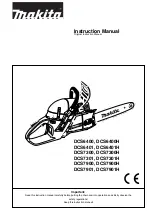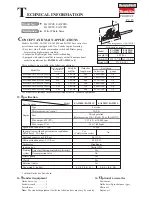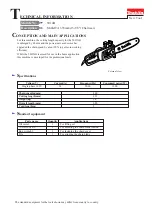
(1) Adjuster
NOTE:
The oil tank should become nearly empty by the time fuel is
used up. Be sure to refill the oil tank every time when re-fuelling
the unit.
Adjusting carburetor (Fig. 14)
The carburetor on your unit has been factory adjusted, but may
require fine tuning due to change in operating conditions. Before
adjusting the carburetor, make sure that the air/fuel filters are clean
and the fuel properly mixed. When adjusting, take the
following steps:
NOTE:
Be sure to adjust the carburetor with the bar chain attached.
1. Stop engine and screw in both H and L needles until they stop.
Do not force or over tighten. Then set them back the intial number
of turns as shown below.
H Needle: 1
3
/
8
L Needle: 1
1
/
4
2. Start engine and allow it to warm up at half-throttle.
3. Turn L needle slowly clockwise to find a position where idling
speed is maximum, then set the needle back a quarter (
1
/
4
) turn
counterclockwise.
4. Turn idle adjusting screw (T) counterclockwise so that the saw
chain does not turn. If idling speed is too slow, turn the screw
clockwise.
5. Make a test cut and adjust the H needle for best cutting power, not
for maximum speed..
(1) L Needle
(2) H Needle
(3) Idle adjusting screw
Carburetor anti-freeze mechanism
Operating the chainsaw in temperature of 0-5
o
C at times of high
humidity may result in ice forming within the carburetor, and this in
turn may cause the output power of the engine to be reduced or for
the engine to fail to operate smoothly. This product has accordingly
been designed with a ventilation hatch at the back of the air cleaner
cover to allow warm air to be supplied to the engine and to thereby
prevent icing from occurring.
Under normal circumstances the product should be used in normal
operating mode, i.e., in the mode to which it is set at the time of
shipment. However when the possibility exists that icing may occur,
the unit should be set to operate in anti-freeze mode before use.
How to switch between operating modes (Fig. 15)
1. Flip the engine switch to turn off the engine.
2. Remove the air cleaner cover from the cylinder cover.
3. Loosen a screw and remove the screen on the back of the air
cleaner cover.
4. Re-attach the screen right side left so the anti-icing plate is on the
right. Re-install the cover.
(1) Air cleaner cover
(2) Anti-icing plate
(3) Screw
(4) Normal operating mode
(5) Anti-freeze mode
(6) Screen
WARNING!
Continuing to use the product in anti-freeze mode even when
temperatures have risen and returned to normal may result in
the engine failing to start properly or in the engine failing to
operate at its normal speed, and for this reason you should
always be sure to return the unit to normal operating mode if
there is no danger of icing occurring.
When using the saw with the anti-freeze mode, frequently check
the screen and keep it clean of saw dust.
Chain brake
This machine is equipped with an automatic brake to stop the saw
chain rotation should kickback occur during cutting operation. The
brake is automatically operated by inertial force which acts on the
weight fitted inside the front guard. This brake can also be operated
manually with the front guard turned down to the guide bar. (Fig.16).
To release brake, pull up the front guard toward the front handle until
“click” sound is heard.
CAUTION
Ensure the brake is fully operational prior to use.
To do this:
(1) Turn off the engine.
(2) Holding the chainsaw horizontally, release your hand from the
front handle, hit the tip of the guide bar to a stump or a piece of
wood, and confirm brake operation. Operating level varies by bar
size. (Fig. 17). In case the brake is not effective, ask our dealer
about inspection and repairing. The engine, if being kept rotated
at high speed with the brake engaged, will heat the clutch,
causing a problem. When the brake is operated while in
operation, immediately release your fingers from the throttle
lever and keep the engine idling.
Fig.13
Fig.14
Fig.15
Fig.16
Stopping engine
1. Release the throttle lever to allow the engine idling for a few
minutes.
2. Put the switch to the “O” (STOP) position. (Fig. 18).
(1) Switch
Sawing
WARNING!
• Before proceeding to your job, read the following sections. It is
recommended to first practice sawing easy logs. This also
helps you get accustomed to your unit.
• Always follow the safety regulations. The chain saw must only
be used for cutting wood. It is forbidden to cut other types of
material. Vibrations and kickback vary with different materials
and the requirements of the safety regulations would not be
respected. Do not use the chainsaw as a lever for lifting,
moving or splitting objects. Do not lock it over fixed stands.
• It is not necessary to force the saw into the cut. Apply only
light pressure while running the engine at full throttle.
• When the saw chain is caught in the cut, do not attempt to pull
it out by force, but use a wedge or a lever to open the way.
Guard against kickback (Fig. 19)
This saw is equipped with a chain brake that will stop the chain
in the event of kickback if operating properly. You must check the
chain brake operation before each usage by running the saw at full
throttle for 1-2 seconds and pushing the front hand guard forward.
The chain should stop immediately with the engine at full speed. If
the chain is slow to stop or does not stop, replace the brake band
and clutch drum before use.
It is extremely important that the chain brake be checked for proper
operation before each use and that the chain be sharp in order to
maintain the kickback safety level of this saw. Removal of the safety
devices. Inadequate maintenance, or incorrect replacement of the
bar or chain may increase the risk of serious personal injury due to
kickback.
Felling a tree (Fig. 20)
(1) Notch cut
(2) Felling cut
(3) Felling direction
1. Decide the felling direction considering the wind, lean of the tree,
location of heavy branches, ease of job after felling and other
factors.
2. While clearing the area around the tree, arrange a good foothold
and retreat path.
3. Make a notch cut one-third of the way into the tree on the felling
side.
4. Make a felling cut from the opposite side of the notch and at a
level slightly higher than the bottom of the notch.
WARNING!
When you fell a tree, be sure to warn any neighbouring workers
of the danger.
Bucking and limbing
WARNING!
• Always ensure your foothold. Do not stand on the log.
• Be alert to the rolling over of a cut log. Especially when
working on a slope, stand on the uphill side of the log.
• Follow the previous sections instructions “guard against kick
back” to avoid kickback of the saw.
Before starting work, check the direction of bending force inside the
log to be cut. Always finish cutting from the opposite side of bending
direction to prevent the guide bar from being caught in the cut.
A log lying on the ground (Fig. 21)
Saw down halfway, then roll the log over and cut from the opposite
side.
A log hanging off the ground (Fig. 22)
In area A, saw up from the bottom one-third and finish by sawing
down from the top. In area B, saw down from the top one-third and
finish by sawing up from the bottom.
Fig.17
Fig.18
Fig.19
Fig.20
Fig.21
Fig.22
633855-Instructions.indd 4
26/3/07 17:05:56
























